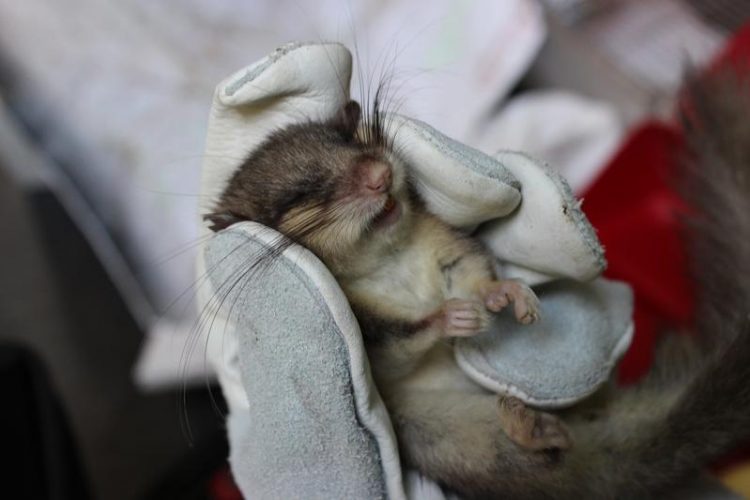Edible Dormice: The older they get, the more they rejuvenate their cells

Relative telomere length can be analysed using extracted DNA of collected buccal mucosa. Vetmeduni Vienna
“As far as I know, no previous study has reported such an effect of age on telomere lengthening,” says Franz Hoelzl, one of the authors. Apparently, this unique pattern is due to the peculiar life history of this species. They can reach maximum lifespan of 13 years, which is a Methuselah-like age for a small rodent.
“This extreme lifespan is almost certainly related to their ability to rejuvenate telomeres”, says Hoelzl. Telomeres are the endcaps of chromosomes, which prevent, together with proteins, the degradation of coding DNA sequences.
Telomeres in small animals shorten fast, but in edible dormice they even grow
In normal somatic cells, telomeres are shortened with every cell division. Besides, oxidative stress has a strong effect on telomere erosion. However, the rate of telomere shortening differs between species. For instance, it has been shown before that telomeres in fast-aging, short-lived wild animals erode more rapidly than in slow-aging, long-lived species.
Earlier this year, the author Franz Hoelzl and his colleagues from Vetmeduni Vienna showed that edible dormice has the capability to re-elongated its telomeres, given that food availability is high. This finding raised the question about the long-term balance between telomere attrition and repair.
The relative telomere length (RTL) gave evidence
To find an answer, the team started a long-tem study on changes in telomere length. In the Vienna Woods in Austria they regularly checked 130 nest-boxes that are occupied by free-living dormice. The researchers collected the rodent’s buccal mucosa for three years. Thus, they could extract the DNA and determine the relative telomere length for each dormouse individually using qPCR. With this method scientists can define the amount of target DNA compared to a reference gene of the same sample.
Elongation does not only occur, it even increases in older edible dormice
“We found out that the telomeres were shortened in young animals but length significantly increased once the dormice were six years old or older. To top it all, the rate of telomere elongation also increased with increasing age of the dormice”, says Franz Hoelzl.
Among the variables tested, only age significantly affected RTL in a non-linear pattern with telomere length decreasing in younger and increasing in older dormice. Hoelz says, “Telomere length was not affected by time of the year, sex, body mass or reproductive activity at the time of sampling.”
Nevertheless, the analysis of long term reproduction-data of the same population shows that the probability to reproduce also increases with age. This finding could indicate that telomere elongation is actually part of the preparation for upcoming reproductive events, as gestation and lactation could increase oxidative stress and the animals may attempt to protect their genome.
Service:
The article “Telomeres are elongated in older individuals in a hibernating rodent, the edible dormouse (Glis glis)“ by Franz Hoelzl, Steve Smith, Jessica S. Cornils, Denise Aydinonat, Claudia Bieber and Thomas Ruf will be published embargoed in Scientific Reports (Nature Publishing Group) today, 24th of November. Embargo ends at 11:00am CET.
About the University of Veterinary Medicine, Vienna
The University of Veterinary Medicine, Vienna in Austria is one of the leading academic and research institutions in the field of Veterinary Sciences in Europe. About 1,300 employees and 2,300 students work on the campus in the north of Vienna which also houses five university clinics and various research sites. Outside of Vienna the university operates Teaching and Research Farms. http://www.vetmeduni.ac.at
Scientific Contact:
Franz Hölzl
Research Institute of Wildlife Ecology
University of Veterinary Medicine Vienna (Vetmeduni Vienna)
T +43 1 25077-7273
franz.hoelzl@vetmeduni.ac.at
Released by:
Georg Mair
Science Communication / Corporate Communications
University of Veterinary Medicine Vienna (Vetmeduni Vienna)
T +43 1 25077-1165
georg.mair@vetmeduni.ac.at
http://www.vetmeduni.ac.at/en/infoservice/presseinformation/presseinformationen-…
Media Contact
All latest news from the category: Life Sciences and Chemistry
Articles and reports from the Life Sciences and chemistry area deal with applied and basic research into modern biology, chemistry and human medicine.
Valuable information can be found on a range of life sciences fields including bacteriology, biochemistry, bionics, bioinformatics, biophysics, biotechnology, genetics, geobotany, human biology, marine biology, microbiology, molecular biology, cellular biology, zoology, bioinorganic chemistry, microchemistry and environmental chemistry.
Newest articles

First-of-its-kind study uses remote sensing to monitor plastic debris in rivers and lakes
Remote sensing creates a cost-effective solution to monitoring plastic pollution. A first-of-its-kind study from researchers at the University of Minnesota Twin Cities shows how remote sensing can help monitor and…

Laser-based artificial neuron mimics nerve cell functions at lightning speed
With a processing speed a billion times faster than nature, chip-based laser neuron could help advance AI tasks such as pattern recognition and sequence prediction. Researchers have developed a laser-based…

Optimising the processing of plastic waste
Just one look in the yellow bin reveals a colourful jumble of different types of plastic. However, the purer and more uniform plastic waste is, the easier it is to…



